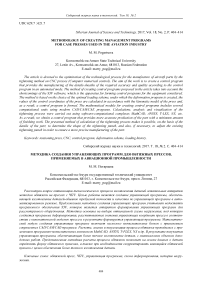Methodology of creating management programs for case presses used in the aviation industry
Автор: Pogartseva M.M.
Журнал: Сибирский аэрокосмический журнал @vestnik-sibsau
Рубрика: Технологические процессы и материалы
Статья в выпуске: 2 т.18, 2017 года.
Бесплатный доступ
The article is devoted to the optimization of the technological process for the manufacture of aircraft parts by the tightening method on CNC presses (Computer numerical control). The aim of the work is to create a control program that provides the manufacturing of the details-sheaths of the required accuracy and quality according to the control program in an automated mode. The method of creating control programs proposed in the article takes into account the shortcomings of the S3F software, which is the apparatus for forming control programs for the equipment considered. The method is based on the choice of the optimal loading scheme, under which the deformation program is created, the values of the control coordinates of the press are calculated in accordance with the kinematic model of the press and, as a result, a control program is formed. The mathematical module for creating control programs includes several computational units using modern CAD/CAM/CAE programs. Calculations, analysis and visualization of the tightening process were carried out using software-computational complexes MathCAD, ANSYS, T-LEX, NX, etc. As a result, we obtain a control program that provides more accurate production of the part with a minimum amount of finishing work. The presented method of calculation of the tightening process makes it possible, on the basis of the details of the part, to determine the shape of the tightening punch, and also, if necessary, to adjust the existing tightening punch in order to ensure a more precise manufacturing of the part.
Tensioning press, cnc, control program, deformation scheme, loading history
Короткий адрес: https://sciup.org/148177715
IDR: 148177715 | УДК: 629.7
Текст научной статьи Methodology of creating management programs for case presses used in the aviation industry
Introduction. Implementation in production of the equipment with the computer numerical control (CNC) is the main objective of scientific and technical progress in aircraft manufacturing industries. More difficult the process of implementation and management of automation systems is being solved in procuring and forming production [1]. Control of any technological process proceeds by means of change of parameters and the modes of processing. Incorrectly selected modes can result in irreversible defects (tucks, gaps) and, as a result, spoilage of details. Therefore, to find the best solution of the task of manufacturing aircraft details with the lowest expenses providing the given quality, optimization of technological processes is necessary. This task is very important, however a question of optimization of technology is very difficult both from mathematical and practical point of view.
Problem statement. To manufacture aircraft parts from sheet procurement by the tightening method at aircraft factories, the presses of cross (Loire T 600, Loire FET 1500/6000) and longitudinal (Loire FEL 2x500) tightening of the French firm ACB are used (fig. 1).
Control of parts of the press can proceed both in manual and in automated (according to the controlling program (CP)) mode. The S3F software which allows to create control program on the basis of geometry of a detail and physicomechanical properties of material which it is made of, is delivered to the enterprises of the aviation industry together with the equipment.
The S3F software is CAM/CAE module which automatically creates control program in the press CNC language on the basis of the built-in kinematic model (KM) of the press. Such method of forming of control program is automated, rather simple and fast. However details formed according to the control program on the basis of the S3F software do not always provide details of the required quality. The reason of such results is a number of restrictions of the S3F software:
– irrespective of a detail form only one option of tightening according to the scheme И-Р is applied (a bend with the subsequent stretching);
– it is difficult to get control program for aircraft parts having difficult geometry (low technological effectiveness);
– algorithms of search of initial position of the press operating parts and their further movement aren’t optimum;
– the deformation model of procurement in use is simplified and doesn’t allow to predict puckering;
– the program doesn’t help to define necessary deformation (it is set by the user);
– doesn’t allow to correct a trajectory of the operating parts of the press movement.
Two versions of the solution of a problem of increase in accuracy of production of the required detail form are possible:
– creation new control program (correction of a trajectory of procurement movement);
– creation new or correction of the available tightening punch.

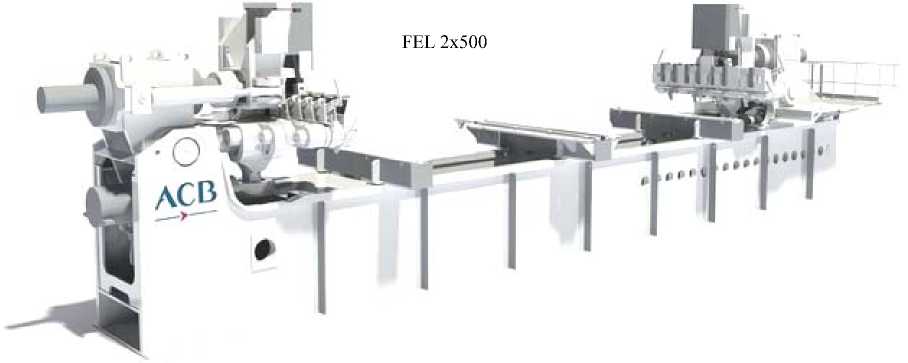
Fig. 1. Tensoning presses
Рис. 1. Обтяжные прессы
As there is no possibility of correction of KM in the S3F software, development of new KM of the press and the mathematical module for forming control program taking into account complexity of geometrical forms of aircraft parts is required. Such KM will give the complete idea of interconnection of movement of parts of the press [2; 3].
The KM in the form of analytical dependences allows to define a necessary combination of values of movements of controlling parameters of the press which will provide more accurate trajectory of tightening of sheet procurement on a punch surface.
Approbation of a trajectory of tightening, distribution of deformations and tension, identification of dangerous sites (zones of possible gaps, formations of folds and puckering) allows the use of CAE software products – ANSYS, MARK, etc.
The KM, realized geometrically in CAD system, allows to define by a graphic method a trajectory of the parts of the press movement on trajectories described by an evolvent. A graphic method is effective to apply only to simple forms of details (an ellipse, the cylinder, a circle). However such search of a trajectory of the movement does not guarantee exact production even for simple forms. Therefore it is convenient to use a graphic method as addition to analytical methods and as means of visualization of a tightening process. To increase accuracy of production of aircraft parts it is necessary to create control program by use of various schemes of loading and optimization of process of tightening. In fig. 2 the scheme of possible ways of realization of process of creating control programs for tensioning presses with CNC is presented.
In fig. 2 the solid lines show an option of control program creation using the S3F software. The dash lines show an option of creation of control program based on a combination of analytical calculations and finite and element modelling. The second option includes several computing units. The dotted lines show an option of creation of control program using graphic programs which is approved by means of finite and element modelling [4].
The analysis of schemes of loading when tightening. As it was stated above, the program of deforming according to the diagram of И-Р is used in the S3F software. The process of B-S is characterized by the fact that a procurement is initially bent on a punch and then in a curved status is exposed to stretching. The frictional forces between a procurement and a punch which appear in the course of stretching reduce the calibrating deformations and exert the negative impact on the process of forming as the detail springing increases.
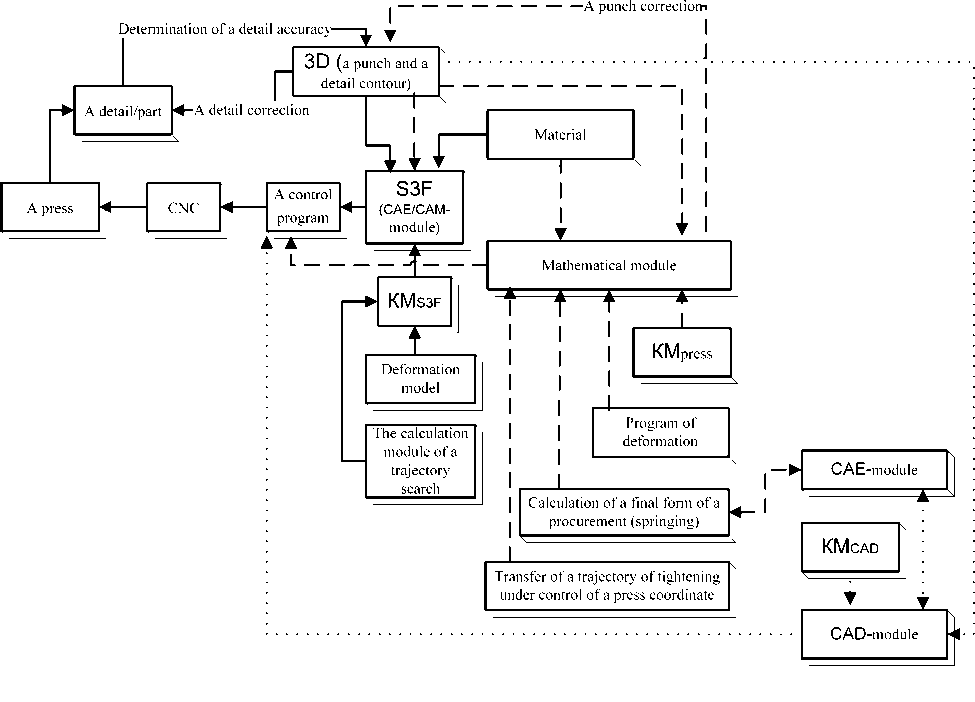
Fig. 2. The diagram of process of creation CP for presses with CNC
Рис. 2. Схема процесса создания УП для прессов с ЧПУ
Technological capabilities of tensioning presses with CNC also allow to realize other schemes: S-B (stretching with the subsequent bend), S1-B-S2 (preliminary stretching, the subsequent bend and the additional calibrating stretching), and also their combinations BS-S (a bend with stretching and the additional calibrating stretching), etc. The process S-B is also characterized by the fact that deformation of stretching uniform on section is originally created, and then at preservation of constancy of the stretching force the bend on a punch of the corresponding curvature is made. Process of S1-B-S2 is a combination of two types of difficult loading of S-B and B1-S to various ratio of sizes of preliminary and additional stretching. In the course of BS-S there is a rounding by a procurement of a working surface of a punch along with procurement stretching, at the same time tension during all process of forming has to increase monotonously in all sections of procurement, so that the forming should occur without unloading. At the same time the angle of coverage of a punch surface by a procurement increases gradually in the process of providing abutment beginning from punch top that promotes reduction of friction forces [5; 6].
In fig. 3 diagrams of deformations and tension for various schemes of tightening and the corresponding charts of deforming are shown.
Formulas for determination of resultant tension for different schemes of loading at the description of a single deformation curve in the form of linearly-stage function of a type are given in table:
[ E-Б, Б<Бп, G = <
[ K -Б n , Б>Б п .
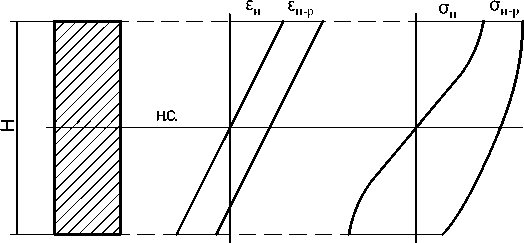
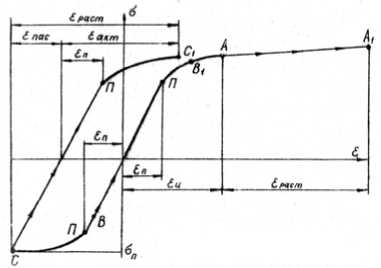
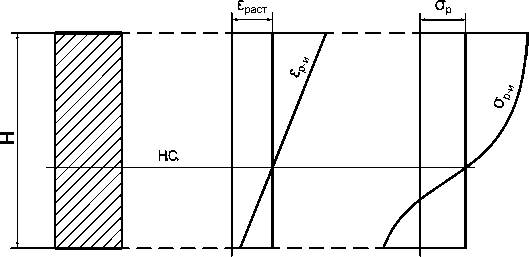
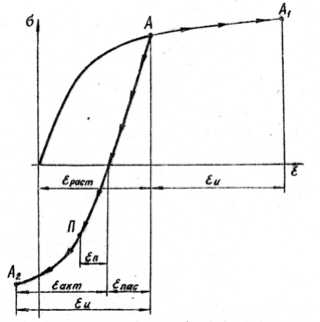
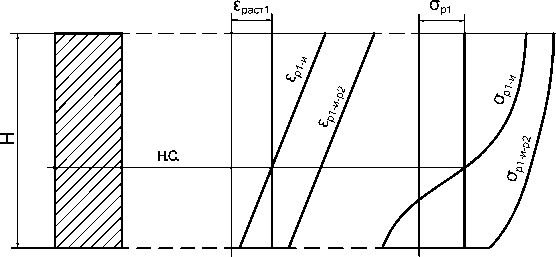
Fig. 3. Diagrams of deformations and tension, charts of deforming
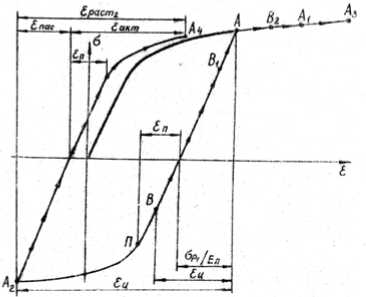
Рис. 3. Эпюры деформаций и напряжений, диаграммы деформирования
The choice of tightening scheme depends on a detail form. Also a technologist faces a question of setting values of initial parameters of tightening process. Therefore when developing technological process it is necessary to carry out the analysis of all schemes of deformation and to choose an optimal variant to manufacture a detail with the least error [7–10].
Definition of a terminating form of a detail for various schemes of a loading. The developed mathematical module allows to calculate analytically a terminating form of a detail using various schemes of tightening. The analysis of results of calculation will allow to choose the most optimal variant of a detail manufacture.
Input data for calculation is the geometrical amount of sheet procurement: Н – thickness of a sheet and В – sheet width; R0nar – the external radius of a bend; E, σ в , σ 02 and δ – mechanical characteristics of material; ε раст1 – the relative deformation of preliminary stretching and ε раст2 – the relative deformation of the calibrating stretching (fig. 4).
For implementation of calculations we break a sheet section by height into a set of elementary strips: M – number of elementary strips in 1 mm; N – quantity of elementary strips by section height; Δh – height of an elementary strip (a step of splitting section of a sheet).
For each elementary strip we determine y k coordinate, width b k and radius ρ k . We calculate tension σ р1 and effort Р р1 of preliminary stretching. We define the intense-deformed state (IDS) of a sheet after preliminary stretching σ р1 , we calculate deformations of a bend ε и and the sheet IDS at a bend after stretching ε р1и and σ р1и.
Using a bisection method we find the radius of R0 and the position of a neutral layer H0. We calculate the moment of inertia of J0 relating to neutral axis. We define the IDS of a closing stage of the process of Р.
S1-B-S2 – the calibrating stretching after a sheet bend with stretching – εр1ир2 and σр1ир2. We calculate the bending moment of Mz and the calibrating effort of Рр2. We find change of the layer curvature passing through the center of gravity Δχct, we determine residual tension σ ost after unloading and the moment of residual tension relating to the center of masses Mz ost . We calculate a layer curvature χ ct passing through the center of gravity after unloading and then we get detail radius after unloading of Rnar [11].
In fig. 5 the algorithm of definition of a detail form after tightening is presented.
The algorithm in fig. 5 is the solution of a problem of definition of terminating position of procurement – detail form. However, if the detail form the complicated (non-technological) then to get a detail without deviations, without completion due to change of the loading scheme only, is not always possible. In such cases it is possible to increase accuracy of manufacture of a detail for the account of a punch correction. Searching for the anticipated form of a punch is the solution of the inverse task presented in fig. 5. The unit of the program of calculation of a punch form correction enters the mathematical module of searching for optimum parameters of technological process of tightening [12–15].
Formulas of determination of resultant tension
|
Scheme |
Calculated formulas |
|
|
(Z) ffl |
Zone of the stretched fibers |
|
|
О и-р _ K п ' ( £ и-р ) £ = S + £ • £ = P i - ^ нс Е и-р Е и + Е раст ; Е и „ R нс |
||
|
Zone of the compressed fibers |
||
|
f Е п - Е акт , if Е акт — Е п , О и О и-р 1 „ / vi . п Еакт Ераст 1 Епас ; Епас [ K п - ( Е акт ) , if Е акт > Е , Е п [ Е п -Е и , if| eи| — Е п и [- К п К Г , if 1£ и| > Е п |
||
|
m (Z) |
Zone of the stretched fibers |
|
|
а р-и =■ |
Е п -Е р-и , if Е р-и — Е п , / х n Е р-и Е раст 1 Е и K п - ( Е р-и ) , if Е р-и > Е п , |
|
|
Zone of the compressed fibers |
||
|
f О р + Е п -Е и , if |би| — Е ас +Е п , О р-и _^ [- K п - (| Е и| -Е пас ) , if |Еи| > Е пас + Е п , Е п - Е раст , if Е раст — Е п , о р О р тл ( \п т Е пас F K п - ( Е раст ) , if Е раст > Е п , п |
||
End table
|
Scheme |
Calculated formulas |
|
СЧ (Z) m (Z) |
Zone of the stretched fibers |
|
О р1-и-р2 = K п ‘ ( ^ р1-и-р2 ) ; £ р1-и-р2 = £ раст1 + £ и + £ раст2 |
|
|
Zone of the compressed fibers |
|
|
О р1 + Е п '(^ и £ раст2 ) , if £ раст2 — £ и , 1 ( nn . . . at ки| — £ пас1 + £ _ K п '( £ р1-и-р2 ) , if £ раст2 >| £ и| , О р1-и-р2 = ] I -^п £акт, х акт ~°п, , , С / V at 1£и| >£ пас1 +£ п [[ K п ‘ ( ^ акт ) , if Е акт > ^ п , Е п '^ раст1, if е раст1 — е п , Q pi Q pi-и
K п (£ раст1 ) , if £ раст1 > ^ п , п п
I - K п ' (| £ и| -£ пас1 ) , if |£и| > £ пас1 + £ п , |


Fig. 4. The position of procurement in the process of tightening
Рис. 4. Положение заготовки в процессе обтяжки


Fig. 5. An algorithm of definition of a detail after tightening (beginning)
Рис. 5. Алгоритм определения формы детали после обтяжки (начало)
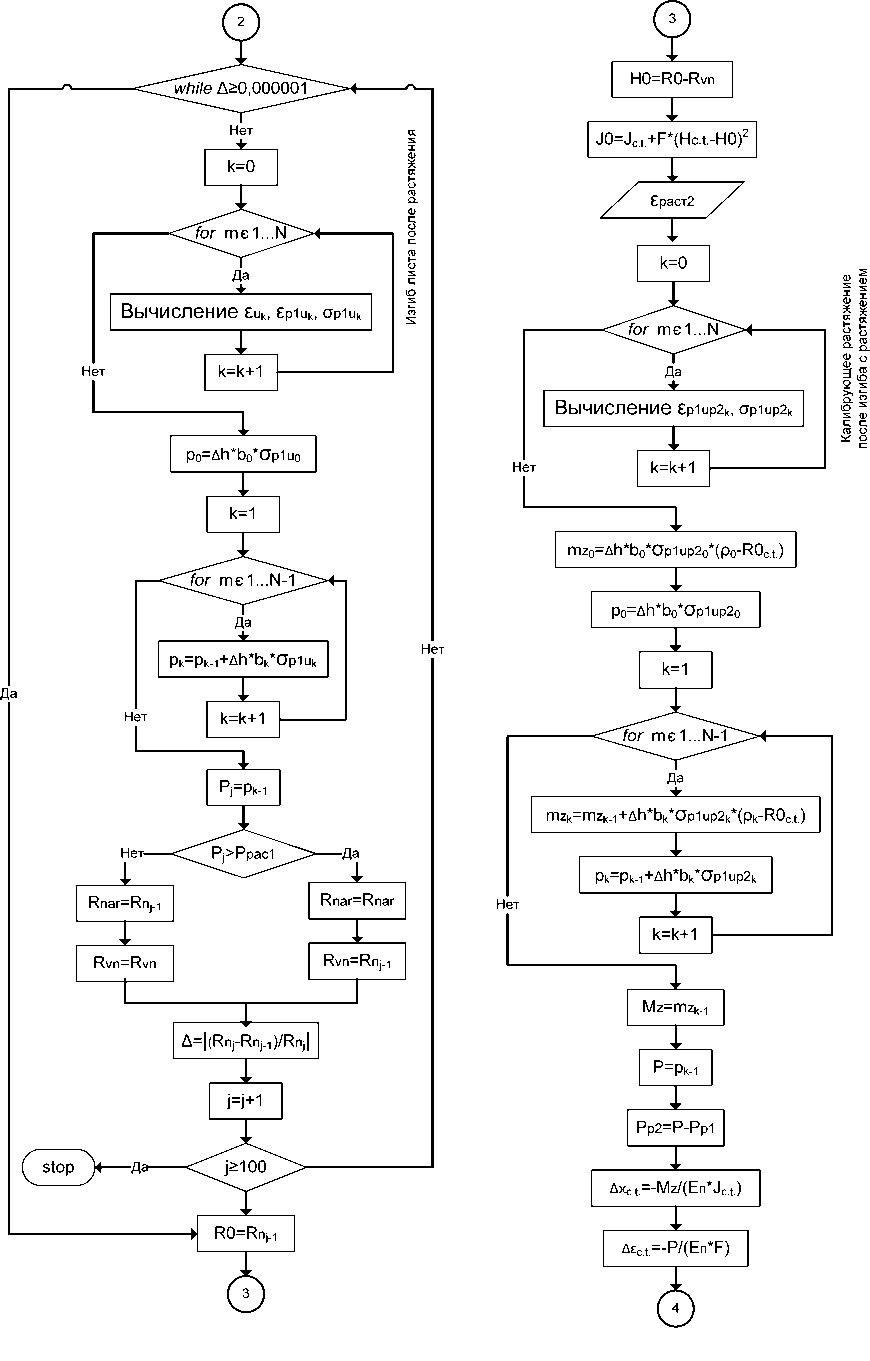
Fig. 5. An algorithm of definition of a detail form after tightening (continuation)
Рис. 5. Алгоритм определения формы детали после обтяжки (продолжение)
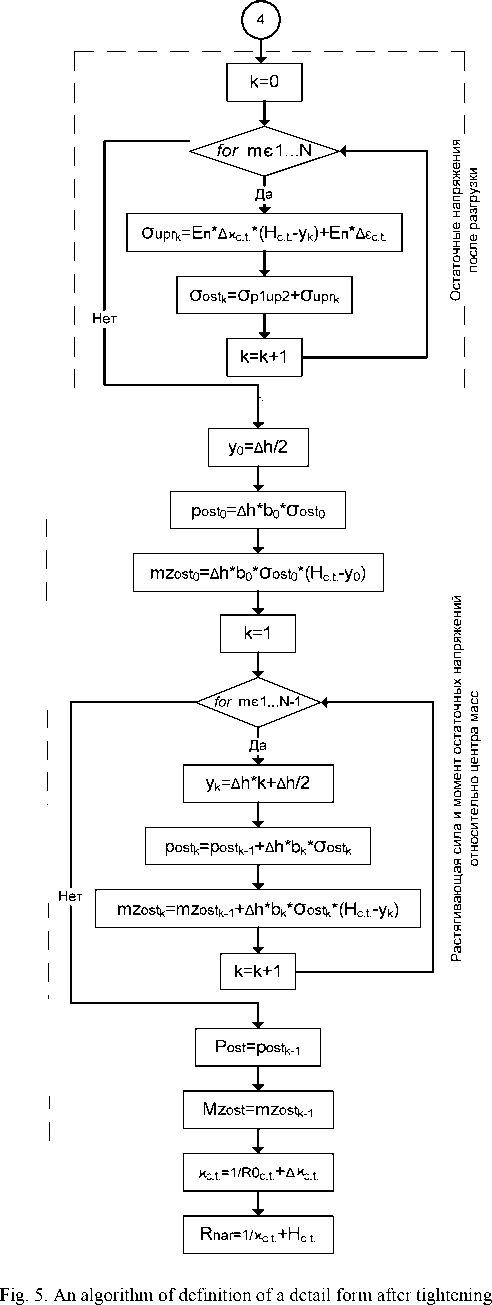
(end)
Рис. 5. Алгоритм определения формы детали после обтяжки (окончание)
Conclusion. The offered method of creating control programs is universal for tensioning presses of aviation assignment. The difference are the KM presses by means of which calculated parameters of process of tightening are transformed to values of controlling coordinates of a press which are reflected in a control program. Creating such control programs allows to make details of high accuracy in an automated mode and also to exclude or minimize the amount of finishing work.
Список литературы Methodology of creating management programs for case presses used in the aviation industry
- Феоктистов С. И. Автоматизация проектирования технологических процессов и оснастки заготовительно-штамповочного производства авиационной промышленности: монография. Владивосток: Даль-наука, 2001. 183 с.
- Погарцева М. М., Феоктистов С.И. Разработка математической модели станка для продольной обтяжки FEL 2х500//Фундаментальные исследования в области создания инновационных технологий и новых материалов, направленных на развитие авиационных и космических комплексов. Достижения фундаментальной науки и образования -в инновационные технологии: материалы Междунар. науч.-техн. конф. и Междунар. молодёжной школы-семинара (12-16 мая 2015, г. Комсомольск-на-Амуре). Комсомольск-на-Амуре: ФГБОУ ВПО «КнАГТУ», 2015. С. 135-136.
- Математическое моделирование технологических процессов изготовления деталей летательных аппаратов/Ю. Л. Иванов . Владивосток: Даль-наука, 2000. 115 с.
- Анализ конструкции и технологии изготовления деталей летательного аппарата из листового материала с использованием программного обеспечения/С. В. Белых //Авиационная промышленность. 2015. № 1. С. 55-59.
- Лысов М. И. Теория и расчет процессов изготовления деталей методами гибки. М.: Машино-строение, 1966. 236 с.
- Лысов М. И., Закиров И. М. Пластическое формообразование тонкостенных деталей авиатехни-ки. М.: Машиностроение, 1983. 176 с.
- Погарцева М. М. Определение формы заготовки с учетом упругого восстановления материала после формообразования и удаления материала в процессе последующего фрезерования//Молодежь. Проекты. Идеи: сб. статей III науч.-практ. конф. (9-11 октября 2013, г. Иркутск). Иркутск: Иркут, 2014. С. 72-76.
- Погарцева М. М. Определение величины пружинения листовой заготовки при изгибе с растяжением и последующем фрезеровании//Молодые ученые -Хабаровскому краю: материалы ХVI краевого кон-курса молодых ученых и аспирантов (17-24 января 2014, г. Хабаровск). Хабаровск: Изд-во Тихоокеан. гос. ун-та, 2014. С. 341-346.
- Феоктистов С. И., Белых С. В., Погарцева М. М. Определение геометрических параметров технологического процесса получения деталей летательных аппаратов из прессованных профилей методом изгиба с последующим фрезерованием//Ученые записки Комсомольского-на-Амуре государственного технического университета. Науки о природе и технике. 2013. № I-1(13). С. 4-11.
- Tianjiao Liua, Yongjun Wanga, Jianjun Wu Springback analysis of Z & T-section 2196-T8511 and 2099-T83 Al-Lialloys extrusions in displacement controlled cold stretch bending//Journal of Materials Processing Technology. 2015. № 225. Р. 295-309.
- Международная энциклопедия CALS. Авиационно-космическое машиностроение/под ред. А. Г. Братухина. М.: ОАО «НИЦ АСК», 2015. 608 с.
- Погарцева М. М., Белых С. В. Методика оптимизации управляющих программ обтяжного пресса типа FET//Авиамашиностроение и транспорт Сибири: сб. статей IV Всерос. науч.-практ. конф. (10-11 апреля 2014 г. Иркутск). Иркутск: Изд-во ИрГТУ, 2014. С. 15-20.
- Погарцева М. М. Методика оптимизации процесса формообразования деталей сложной геометрии из листа методом продольной обтяжки на оборудовании, оснащенном ЧПУ//Наука молодых -основа будущего России: материалы докладов конкурса научно-исследовательских работ аспирантов и молодых ученых Комсомольского-на-Амуре государственного технического университета. Комсомольск-на-Амуре: ФГБОУ ВПО «КнАГТУ», 2014. С. 28-33.
- Погарцева М. М. Методика оптимизации процесса формообразования деталей сложной геометрии из листа методом продольной обтяжки на прессе FEL//Фундаментальные исследования в области создания инновационных технологий и новых материалов, направленных на развитие авиационных и космических комплексов. Достижения фундаментальной науки и образования -в инновационные технологии: материалы Междунар. науч.-техн. конф. и Междунар. молодёжной школы-семинара (12-16 мая 2015. г. Комсомольск-на-Амуре). Комсомольск-на-Амуре: ФГБОУ ВПО «КнАГТУ», 2015. С. 132-134.
- Погарцева М. М., Феоктистов С. И. Методика оптимизации процесса формообразования деталей сложной геометрии из листа методом продольной обтяжки на оборудовании, оснащенном ЧПУ//Молодежь XXI века: III и IV науч.-практ. конф.: сб. тр. Владивосток: Изд-во Дальневост. ун-та, 2015. С. 393-396.

